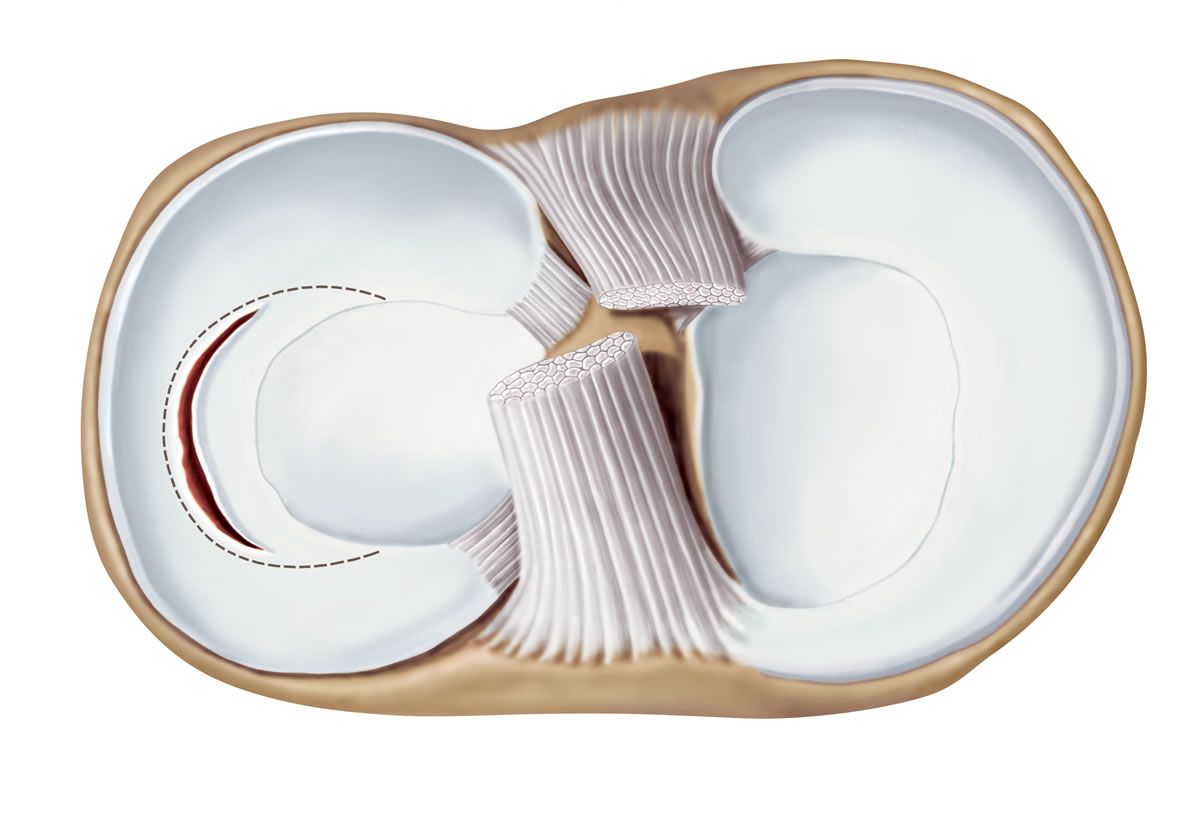
Meniscus Repair
The meniscus is a c-shaped piece of tough, rubbery cartilage that is vital for the function of the knee joint. They are two in number i.e. medial and lateral. There are 3 zones of every meniscus. Namely, the red zone, the red-white zone and the white-white zone. The meniscus is attached to the tibia anteriorly and posteriorly at the root of the meniscus and peripherally to the knee capsule. The meniscus is attached to the femur with help of ligaments which are called the meniscofemoral ligaments. In case of any injury, Knee Arthroscopy Meniscectomy or Knee Arthroscopy Meniscus Repair is suggested by the doctors at Kapadia Multispeciality Hospital.
Functions of the Menisci:
- Acts as a shock absorber.
- Aids in maintaining the knee joint's flexibility.
- Weight transmission of 40-70 per cent of the load across the knee joint.
- Aids in the articular cartilage's nourishment.
- Aids and regulates the way the knee moves during bending and straightening of the knee joint.
Medial Meniscus Injury:
The medial meniscus is on the inside of the knee more commonly injured than the lateral and is usually associated with other ligament injuries of the knee.
Different Types of Meniscal Injuries:
- Longitudinal tears (35%) — In these peripheral attachments tear are 10 per cent, complete tear are 23 per cent and segmental tear are 2 per cent.
- Horizontal Tears (48%) — Could be Posterior, Middle, or Anterior.
- Cystic Degeneration (12%)
- Congenital Abnormalities 5 per cent.
- Regenerative Lesions
Mechanism of Injury:
- A rotational force or twisting injury is responsible for causing a meniscus tear.
- In young, it can occur only when weight is being taken, the knee is flexed and there is a twisting strain. Young active athletes are more prone.
- In middle life, fibrosis has decreased the mobility of the meniscus and hence tear occurs with less force.
Predisposing Factor:
These may include irregular stress caused by persistent ligament instability, aberrant strain due to meniscal abnormality, etc.
Symptoms:
Initial injury
- The patient reports knee pain on the inside
- History of locking
- Swelling of the knee
- Knee periodically gives trouble
- Sensation that something is shifting inside the joint
- Click
- Knee feels normal between incidents
Investigation:
- Radiograph
- MRI
- Arthroscopy
Treatment:
Conservative treatment is useful for the following types of meniscus tears
- Stable Tears
- Degenerative Tears
- Peripheral Tears
- Horizontal Tears
Measures:
Conservative treatment is useful for the following types of meniscus tears
- Abstinence from weight bearing.
- Rest, Ice Packs, Compressive Bandage.
- Joint Aspiration.
- Quadriceps Exercises.
Surgery Indications:
Surgery is indicated, if the joint cannot be unlocked or if symptoms of pain are recurrent or if meniscus tears are associated with other ligament injuries like ACL or PCL tears.
Methods:
Meniscus surgeries are always arthroscopic surgeries and can be either Knee Arthroscopy Meniscectomy or Arthroscopic Meniscus Repair depending on the type of tear, site of the tear, age of the patient, time since the injury and profession of the individual.
Knee arthroscopy Meniscectomy essentially means removing a part of the torn meniscus. It relieves the symptoms caused due to the meniscus tear like pain, locking or difficulty in flexing the knee, but as Knee arthroscopy Meniscectomy removes a part of the meniscus, it takes away some of the functions that the meniscus does and if the total meniscus is removed, it may lead to early osteoarthritis.
The preferable option for most acute meniscus tears is Arthroscopic Meniscus Repair. There are 3 main ways to do an Arthroscopic Meniscus Repair: all inside, inside out and outside in techniques. Most complex tears require a combination of the three techniques for a complete repair of the meniscus. A few chronic tears are not amenable to repair and these tears have to undergo knee arthroscopy meniscectomy and residual meniscus has to be balanced.
The treatment of the meniscus injury also depends on the type of tear and the zone of the injury. Longitudinal peripheral tears are in the red zone and these have a higher chance of healing unlike the radial tears or the oblique tears that are in the white zone and do not heal that well.
Meniscus Root Tears
Meniscus root tears are radial tears that are close to either the posterior or the anterior root of the meniscus. A meniscus root tear is essentially acting as a complete meniscectomy and can lead to the rapid progression of osteoarthritis. The posterior root of the medial meniscus is the most frequently torn. The main reasons for a meniscal root tear are traumatic or degenerative. A traumatic meniscal root tear in an otherwise normal knee needs to be addressed and arthroscopy meniscus repair is the gold standard treatment for the same. Degenerative meniscal root tears in an arthritic knee can be treated conservatively.
If you are finding the Best Doctor for Meniscus Repair or Arthroscopy Meniscectomy, Kapadia Multispeciality Hospital is your destination! To know more visit us or contact us via the website.
To know more kindly contact the best orthopaedic surgeon Dr. Rahul Modi for further queries.
This surgery is frequently performed by the best orthopaedic surgeon Dr. Rahul Modi for treating Meniscus Repair EDT.